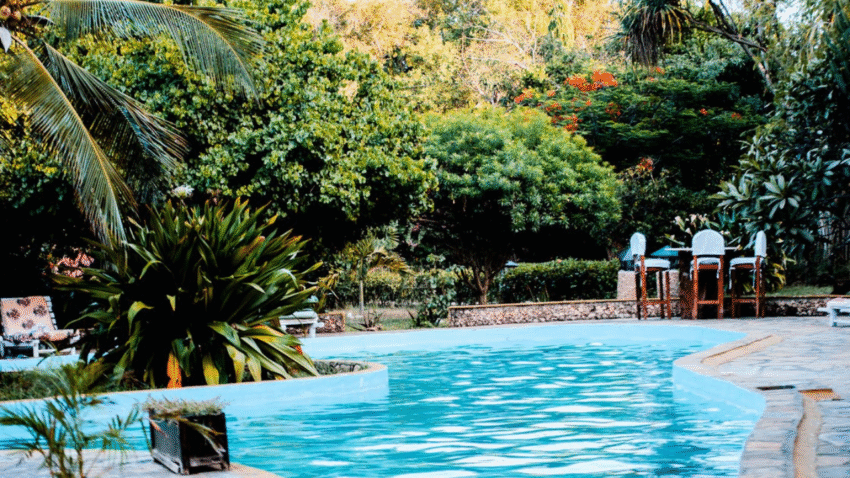Introduction
Want to keep your pool water clean and crystal clear without spending a fortune on high-end equipment? Learning how to test pool water with test strips is a quick, affordable, and effective way to monitor your pool’s chemistry. In this step-by-step guide, you’ll discover exactly how to use pool test strips properly so you can maintain a healthy and safe swimming environment all season long.
Why Testing Pool Water Matters
Your pool may look clean, but invisible issues like low chlorine or imbalanced pH can lead to:
- Cloudy or green water
- Algae growth
- Skin and eye irritation
- Damage to your pool surfaces and equipment
Regular water testing helps you:
- Maintain proper pH and sanitizer levels
- Avoid expensive repairs or algae outbreaks
- Keep your swimmers safe and comfortable
Test strips make this easy by giving you fast results right from the poolside in under a minute.
Step-by-Step Guide to Testing Pool Water with Test Strips
Step 1: Choose the Right Test Strips
Not all test strips are the same. Look for a high-quality pool test strip kit that tests for the essential chemical levels, including:
- Free Chlorine or Bromine
- pH
- Total Alkalinity
- Cyanuric Acid (stabilizer)
- Total Hardness
Pro Tip: For saltwater pools, choose strips that also test for salt levels.
Stick with trusted brands and check expiration dates. Old strips can give inaccurate readings.
Step 2: Read the Instructions on the Packaging
Before using the strips, take a minute to read the manufacturer’s instructions. Different brands may have slight variations in timing, dipping method, or how the results should be interpreted.
Important: Don’t assume all test strips are used the same way—reading the label ensures accurate results.
Step 3: Collect a Water Sample (Optional But Helpful)
While you can dip the strip directly into the pool, it’s better to collect a water sample from elbow depth (about 18 inches below the surface) in a clean container.
- Avoid testing near return jets or skimmers where water might be circulating unevenly.
- Use a clean plastic cup or pool water testing vial.
Tip: Testing away from the edge provides a more accurate representation of overall pool chemistry.
Step 4: Dip the Test Strip into the Water
Take one test strip from the container and quickly dip it into the water (either directly in the pool or in your sample). Do not swirl or shake it.
- Submerge for 2–3 seconds unless the instructions say otherwise.
- Remove the strip and hold it level (do not shake off excess water).
Let the strip sit still while the color pads develop—usually within 15–30 seconds.
Step 5: Compare Colors to the Chart
Once the strip has developed, compare the color pads to the guide printed on the bottle or included chart.
- Line up the strip next to the chart
- Match each color pad (pH, chlorine, etc.) to the closest corresponding color
- Record your results if you’re tracking water chemistry over time
Caution: Read the strip under natural light for the most accurate color matching.
Step 6: Interpret the Results
Use the color readings to determine if your pool water is balanced. Ideal pool chemistry ranges include:
| Chemical | Ideal Range |
|---|---|
| Free Chlorine | 1–3 ppm |
| pH Level | 7.2–7.6 |
| Total Alkalinity | 80–120 ppm |
| Cyanuric Acid | 30–50 ppm (outdoor pools) |
| Calcium Hardness | 200–400 ppm |
If any readings fall outside the ideal range, you’ll need to adjust your chemicals accordingly.
Pro Tip: Keep a logbook or app to track your weekly readings and spot patterns over time.
Step 7: Adjust Pool Chemicals (If Needed)
Use your readings to make smart decisions about chemical adjustments:
- Low chlorine? Add liquid chlorine or shock the pool.
- High pH? Add muriatic acid.
- Low alkalinity? Add sodium bicarbonate (baking soda).
- Low stabilizer? Add cyanuric acid.
Always add chemicals gradually and according to the product instructions. Re-test 4–6 hours after adding chemicals to see how the water responds.
Common Mistakes to Avoid
- Dipping Too Long or Shaking the Strip
- Can skew results and lead to poor decisions.
- Solution: Dip for the correct amount of time and hold it steady for color development.
- Touching the Pads with Your Fingers
- Oils or moisture from your hands can distort the readings.
- Solution: Handle strips by the end and avoid contact with the pads.
- Storing Strips Improperly
- Humidity and heat can ruin test strips.
- Solution: Keep the container sealed tightly and store in a cool, dry place.
- Using Expired Test Strips
- Old strips can give false readings.
- Solution: Check the expiration date before use and replace when needed.
- Testing Near Jets or Skimmers
- The water there isn’t representative of your whole pool.
- Solution: Take a sample from 18 inches below the surface in a central spot.
Extra Tips & Pool Hacks
- Test at the Same Time Each Week: Morning or early evening is ideal for consistency.
- Test More Often After Storms or Pool Parties: Heavy rain and extra swimmers can throw off your water chemistry.
- Use a Digital Reader (Optional): Some brands offer companion apps or devices to scan your strip for ultra-accurate readings.
🧪 Need help adjusting your results? Read our article on how to balance pool water chemicals for an easy follow-up.
Conclusion
Testing your pool water with test strips is one of the easiest and most affordable ways to keep your pool safe, clean, and enjoyable. With just a few seconds of effort each week, you can stay ahead of algae, avoid equipment damage, and keep your swimmers smiling.
💡 Final Tip: Make water testing a part of your weekly pool routine—your pool (and your wallet) will thank you later!
